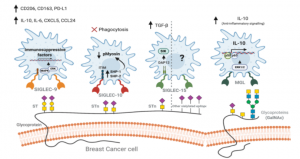There was a review on aberrant glycosylation in breast cancer and its relationship with macrophages. Important points from this revie was summarized here.
https://www.mdpi.com/1422-0067/22/4/1972/htm
The following things have been reported about aberrant glycosylation observed in breast cancer,
increase in Lewisa Lewisx,
increase in Core Fucose,
increase in branched N-glycans,
truncation of O-glycans,
and, increase in sialo-glycans for both N-glycans and O-glycans.
The breast cancer microenvironment is composed of mainly by stromal cells and immune cells infiltrated. It would be so important to understand interactions between breast cancer cells and immune cells (typically macrophages) from a view point of cancer therapy.
From this point, SIGLEC-9, SIGLEC-10, SIGLEC-15, and MGL would be hot spots. SIGLEC-9 binds to Sialyl-T enriched MUC1, and activate MAPK-ERK signal path leading to increase in immune checkpoint PD-L1 expression and and IL-10 secretion. SIGLEC-10 binds to Sialyl-T and Sialyl-Tn antigens, and suppress macrophage’s phagocytosis. SIGLEC-15 binds to Sialyl-Tn antigens, and seems to activate SYK/MAPK signal path, rather than stimulating TGF-ベータecretion, although the functions are not clearly identified. On the other hand, MGL bids to GalNAc, and is related to activation of ERK signal path and secretion of IL-10. These points would be drug development targets for the breast cancer.

